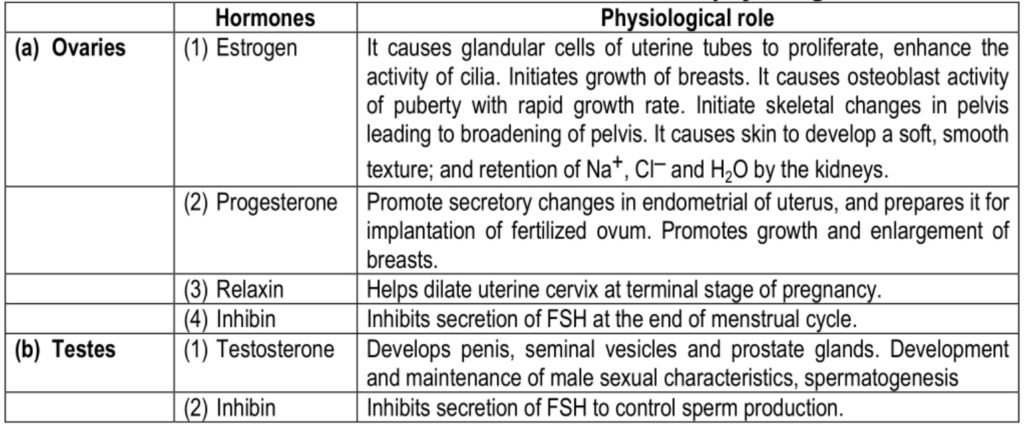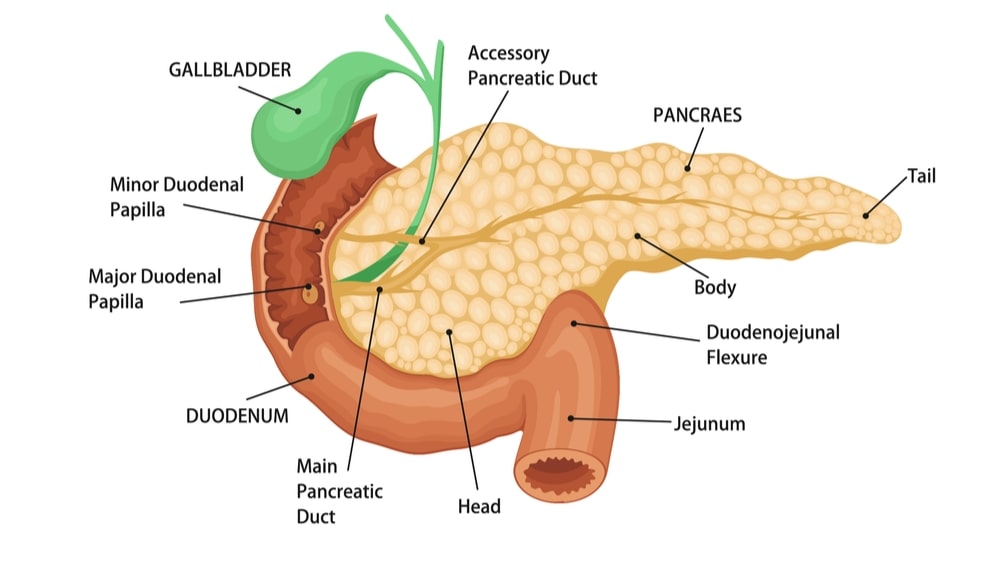The pancreas is located in the abdominal cavity behind and slightly inferior to the stomach, between the duodenum and spleen. The functions of the pancreas are both exocrine and endocrine glands. The endocrine portion of the gland consists of groups of tiny cells scattered in the exocrine portion. These cells are known as islets of Langerhans. Four types of such cells have been identified secreting different hormones.
- Alpha cells secrete the hormone glucagon.
- Beta cells secrete the hormone insulin.
- Delta cells secrete the hormone Somatostatin or Growth Hormone Inhibiting Hormone (GHIH) and
- F-cells secrete pancreatic polypeptide. The exact origin of these endocrine cells is not known. The pancreatic endocrine cells have a rich blood supply and are innervated by both sympathetic and parasympathetic nerves.
Pancreatic Hormones and Functions of Pancreas
Insulin
The beta cells of islets of Langerhans produce insulin. Insulin facilitates the transport of glucose into the cells (Glucose uptake). It enhances glycogenesis (conversion of glucose into glycogen). It accelerates the conversion of glucose into fatty acids (Lipogenesis) and reduces gluconeogenesis (formation of glucose from non-carbohydrate sources). All these effects lead to a decrease in the glucose level of the blood. (Hypoglycemia).
Glucagon
The alpha cells of islets of Langerhans secrete glucagon. It has opposite effects to that of insulin. It increases the blood glucose level. In the liver, it accelerates the conversion of glycogen into glucose (Glycogenolysis). It promotes gluconeogenesis and enhances the release of glucose into the blood.
Somatostatin
The hormone secreted by delta cells of Islets of Langerhans is Somatostatin. It acts as a peregrine to inhibit the secretion of alpha and beta cells of Islets.
The pancreatic polypeptide secreted by F-cells regulates the release of pancreatic digestive enzymes.
Release of Pancreatic Hormones
The release of Pancreatic hormones is controlled by chemical, hormonal and neural stimuli. The blood glucose level appears to be the major factor that governs the release of both insulin and glucagon. A higher blood glucose level stimulates insulin release while a lower blood glucose level stimulates glucagon release. The hormones secreted by cells of the gastrointestinal tract such as secretin, gastrin, and cholecystokinin promote insulin release. Somatostatin inhibits the secretion of both insulin and glucagon. Parasympathetic activity releasing acetylcholine stimulates insulin release while sympathetic transmitters epinephrine and nor-epinephrine inhibit insulin release.
Pancreatic Disorders
The commonest pancreatic endocrine disorder is a deficiency of insulin leading to diabetes mellitus. There is an increase in blood glucose levels (hyperglycemia). The condition is characterized by Polyuria (excessive urine production), Polydipsia (excessive thirst), and Polyphagia (excessive eating). The glucose is passed in urine (glucosuria). There are two main types of diabetes mellitus: Insulin-Dependent Diabetes Mellitus (IDDM) and Non-Insulin Dependent Diabetes Mellitus (NIDDM). In the first type, there is an absolute deficiency of insulin and the patient needs regular administration of insulin by injection. It appears to be an autoimmune disorder where a person’s immune system destroys the beta cells of Islets. The inability of body cells to uptake and utilize glucose leads to the production of ATP from fatty acids. This causes ketoacidosis. Catabolism of proteins and stored fats leads to weight loss. Mobilization of fat from fat depots and its transport to cells may result in the deposition of fat in the wall of blood vessels. This leads to a variety of cardiovascular problems such as atherosclerosis, ischemic heart disease, peripheral vascular disease, and gangrene. Loss of vision due to cataracts (excessive glucose bound to lens proteins) or damage to blood vessels of the retina is another important complication of diabetes.
Non-insulin-dependent diabetes mellitus (NIDDM) is more common than IDDM. It occurs in persons above 40 years of age. The symptoms are comparatively mild and high blood glucose can be controlled by diet, exercise, and weight loss. An antidiabetic drug that stimulates beta cells to secrete insulin is also useful to control the condition. In this type, there is no deficiency of insulin but cells become less sensitive to insulin and hence cannot uptake and utilize glucose.
Gonads
The male and female reproductive glands the testes and ovaries respectively secrete hormones known as sex hormones that regulate and control the reproductive functions of the body.
A brief account of hormones secreted by these gonads and their physiological role is given here in table 1.1.

Make sure you also check our other amazing Article on: Adrenal Glands
